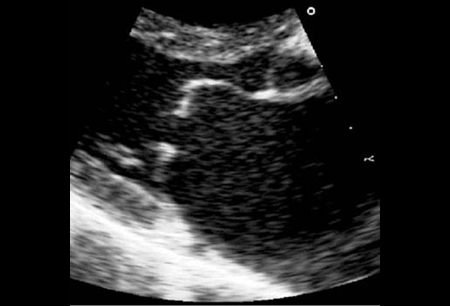Resumo
Definição
História e exame físico
Principais fatores diagnósticos
- history of rheumatic fever
- dyspnea
- orthopnea
- opening snap on auscultation
- diastolic murmur
- loud P2
- neck vein distension
- paroxysmal nocturnal dyspnea
- hemoptysis
- hoarseness
- peripheral edema
- ascites
Outros fatores diagnósticos
- 40-50 years old in rheumatic mitral stenosis, 70-90 years old in mitral annular calcification (MAC)-related disease
- loud first heart sound (S1)
- irregularly irregular pulse
- flushed cheeks
Fatores de risco
- streptococcal infection
- female sex
- ergot medications
- serotonergic medications
- systemic lupus erythematosus (SLE)
- amyloidosis
- bronchial carcinoid syndrome
- atherosclerotic risk factors
Diagnostic tests
1st tests to order
- ECG
- CXR
- transthoracic echocardiography
Tests to consider
- transesophageal echocardiography (TEE)
- cardiac catheterization
- dynamic exercise testing
Treatment algorithm
nonpregnant
pregnant
Contributors
Authors
Blase Carabello, MD

Professor Emeritus, East Carolina University
Director Valve Program, Roper St Francis Health Care
Charleston
SC
Disclosures
BC declares that he has no competing interests.
Peer reviewers
John R. Charpie, MD, PhD
Associate Professor of Pediatrics
Medical Director
Pediatric Cardiothoracic Intensive Care Unit
University of Michigan Congenital Heart Center
C.S. Mott Children's Hospital
Ann Arbor
MI
Disclosures
JRC declares that he has no competing interests.
David Leaf, MD, MPH
Professor of Medicine
VA Greater Los Angeles Healthcare System
UCLA School of Medicine
Los Angeles
CA
Disclosures
DL declares that he has no competing interests.
Peer reviewer acknowledgements
BMJ Best Practice topics are updated on a rolling basis in line with developments in evidence and guidance. The peer reviewers listed here have reviewed the content at least once during the history of the topic.
Disclosures
Peer reviewer affiliations and disclosures pertain to the time of the review.
References
Key articles
Stollerman GH. Rheumatogenic streptococci and autoimmunity. Clin Immunol Immunopathol. 1991 Nov;61(2 Pt 1):131-42. Abstract
Fawzy ME, Choi WB, Mimish L, et al. Immediate and long-term effect of mitral balloon valvotomy on left ventricular volume and systolic function in severe mitral stenosis. Am Heart J. 1996 Aug;132(2 Pt 1):356-60. Abstract
Writing Committee Members; Otto CM, Nishimura RA, Bonow RO, et al. 2020 ACC/AHA guideline for the management of patients with valvular heart disease: a report of the American College of Cardiology/American Heart Association Joint Committee on Clinical Practice Guidelines. J Am Coll Cardiol. 2021 Feb 2;77(4):e25-197.Full text Abstract
Wilkins GT, Weyman AE, Abascal VM, et al. Percutaneous balloon dilatation of the mitral valve: an analysis of echocardiographic variables related to outcome and the mechanism of dilation. Br Heart J. 1988 Oct;60(4):299-308.Full text Abstract
Palacios IF, Sanchez PL, Harrell LC, et al. Which patients benefit from percutaneous mitral balloon valvuloplasty? prevalvuloplasty and postvalvuloplasty variables that predict long-term outcome. Circulation. 2002 Mar 26;105(12):1465-71.Full text Abstract
Reyes VP, Raju Bs, Wynne J, et al. Percutaneous balloon valvuloplasty compared with open surgical commissurotomy for mitral stenosis. N Engl J Med. 1994 Oct 13;331(15):961-7.Full text Abstract
Subbarao KS, Nachiappan M, Irineu AP. Transventricular mitral commissurotomy in critical mitral stenosis during pregnancy. Asian Cardiovasc Thorac Ann. 2004 Sep;12(3):233-5. Abstract
Delgado V, Ajmone Marsan N, de Waha S, et al. 2023 ESC guidelines for the management of endocarditis: developed by the task force on the management of endocarditis of the European Society of Cardiology (ESC) endorsed by the European Association for Cardio-Thoracic Surgery (EACTS) and the European Association of Nuclear Medicine (EANM). Eur Heart J. 2023 Oct 14;44(39):3948-4042.Full text
Reference articles
A full list of sources referenced in this topic is available to users with access to all of BMJ Best Practice.

Differentials
- Left atrial myxoma
- Unexplained atrial fibrillation
More DifferentialsGuidelines
- 2021 AHA/ACC/ASE/CHEST/SAEM/SCCT/SCMR guideline for the evaluation and diagnosis of chest pain: a report of the American College of Cardiology/American Heart Association Joint Committee on clinical practice guidelines
- 2021 ESC/EACTS guidelines for the management of valvular heart disease
More GuidelinesPatient information
Atrial fibrillation
Heart failure
More Patient informationVideos
Mitral stenosis (severe)
More videosLog in or subscribe to access all of BMJ Best Practice
Use of this content is subject to our disclaimer